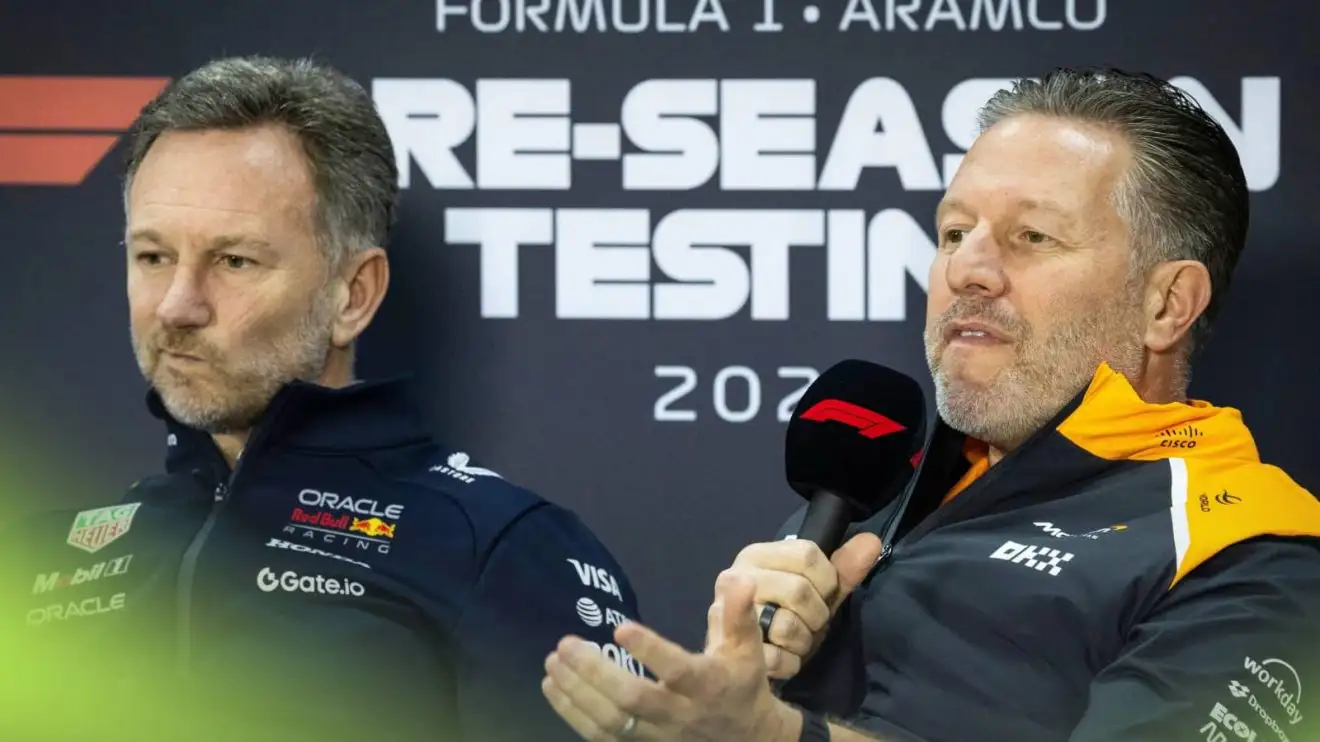McLaren and Red Bull at odds over latest FIA action with ‘oddball’ spotted
27 Feb 2025 7:45 AM

Christian Horner and Zak Brown appear in a press conference during pre-season testing in Bahrain
McLaren boss Zak Brown has downplayed the impact that the FIA’s clampdown on flexi-wings will have on the F1 2025 pecking order as he’s not expecting “there to be a winner and loser.”
Yet Red Bull team principal Christian Horner says the effect of the Spanish Grand Prix technical directive will be “interesting” to monitor, arguing that the timing of it makes for a “slight oddball.”
‘Too hard to tell who wins or loses’ in flexi-wing clampdown
Additional reporting by Thomas Maher
The FIA is introducing more stringent rear wing flex tests this season, which come into effect from the opening round in Australia, while stricter front wing tests will also be in play from race nine in Spain.
Motorsport’s governing body announced the revisions to TD018 in January after flexi-wings made headlines last season.
Red Bull and Ferrari questioned McLaren and Mercedes’ front wings but their concerns were shut down when the FIA, who carry out front wing checks at every race, concluded: “All front wings are currently compliant with the 2024 regulations.”
McLaren’s rear wing also courted controversy when FOM’s cameras focused on the rearward-facing view from Oscar Piastri’s car as he was hunted by Charles Leclerc at the Azerbaijan Grand Prix.
It was clear in the footage that the MCL38’s rear wing deformed at high speeds and such was the flex, that it was dubbed a mini-DRS as it helped shed drag.
The rear wing though, had passed all of the FIA static load tests but McLaren voluntarily modified it as well as their entire rear wing roster, a spokesperson telling PlanetF1.com: “We have made minor adjustments to all our rear wings since Baku to varying extents to ensure no further issues in this area.”
This year the FIA is taking steps to clampdown on teams running flexi-wings with more stringent rear wing testing beginning in Australia while in Spain the front wings will also be subject to harsher tests.
Explained: The FIA’s clampdown on flexi front wings
👉 Why FIA are taking back seat on McLaren and Mercedes front wings
👉 F1 teams set for tougher front wing flex rules as new tests introduced
The timing of the revised technical directive has perplexed some in the paddock with concerns that F1 2025 could be a two-part championship: pre-TD and post-TD.
Brown, though, very much doubts it will have any impact on Formula 1’s pecking order.
“I don’t think it’s a significant change for us,” he told the media including PlanetF1.com in Bahrain.
“I think it’s too hard to tell who wins or loses over it, because I don’t think it’s going to be a material change for anybody.
“I’m not expecting there to be a winner and loser, or some change in the pecking order at that time because of that change.”
However, his Red Bull counterpart Christian Horner isn’t as convinced that there won’t be any consequences as he once again questioned the “race nine” timing of the TD.
“It’ll be interesting the effect that it has,” he said. “I guess the slight oddball about it is the timing of it.
“Why race nine? It might have been better to have been addressed during the off-season, because you end up doing two specs of wings.
“But who will gain or who will lose from it, I think, is impossible to predict.”
The FIA explained the decision for the timing of the staggard testing when they confirmed the change from 15mm of permitted flex to 10mm.
“This phased approach allows teams to adapt without the need to discard existing components unnecessarily,” said motorsport’s governing body.
“These adjustments are aimed at further refining our ability to monitor and enforce bodywork flexibility regulations, ensuring a level playing field for all competitors to promote fair and exciting racing.”
Read next: Mercedes experiment with different nose tip solutions on striking W16
Christian Horner
Zak Brown